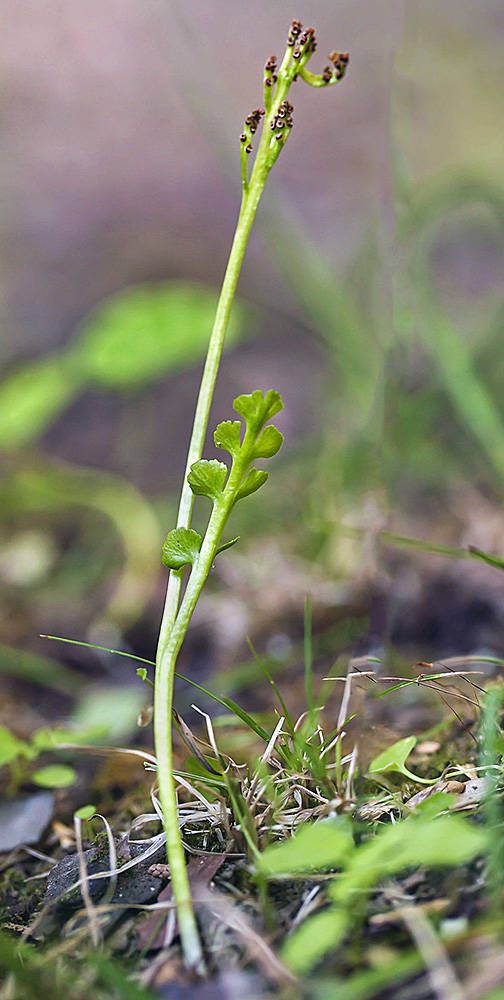Botrychium crenulatum
Botrychium pinnatum
crenulate moonwort, dainty moonwort
northwestern moonwort
45(40–48) μm.
36– 45 μm.
well developed; greater than 3 cm, green.
well developed; greater than 2 cm except in very small plants, sometimes with a reddish brown stripe below trophophore.
stalk (1)5(17) mm long;
blade 1-pinnate; ovateoblong to linear-oblong; to 6.5 × 1.8 cm (averaging 2 cm long), yellow-green, usually with a thin, herbaceous texture;
pinnae in (2)3(5) pairs, overlapping or not, spreading at nearly a right angle to rachis; fan-shaped, spanning an arc of 60–150(180)°; broadest at the outer margin, usually finely crenulate and sometimes with 1–5 incisions.
sessile or rarely with stalk to 2 mm long;
blade pinnate-pinnatifid, oblong to subdeltate; to 8 × 5 cm; grass-green and lustrous, not glaucous;
pinnae spreading or slightly ascending, approximate to overlapping; ovate to lanceolate-oblong; broadest at or below the middle, symmetrically lobed;
pinnae lobes with rounded to broadly acute apices;
sporangia rarely present on pinnae margins.
erect;
stalk 0.5–2 times as long as the trophophore at spore release;
branches well developed, usually spreading or twisted downwards.
erect, usually pinnately branched;
stalk 0.5–1 times as long as the trophophore at spore release.
=90.
=180 (allotetraploid, derived from B. lanceolatum and B. lunaria).
Botrychium crenulatum
Botrychium pinnatum
Moist to saturated soils in or near seeps, fens, or on the margins of small streams, usually among low, dense herbaceous cover, from mid-montane to subalpine elevations. 1200–2100 m. BR, BW. CA, ID, NV, WA; western North America. Native.
Botrychium crenulatum grows in more saturated substrates than most other moonworts. It is frequently confused with B. minganense, from which it can usually be distinguished by the two to five pairs of fan-shaped, spreading pinnae with finely crenulate margins, thinner texture, and spreading or downwardpointing sporophore branches. However, many plants do not exhibit all of these characters.
Moist meadows, forest openings, along small streams under shrubs or conifers, gravel road shoulders, and old clearcuts, at upper montane to subalpine elevations. 1400–3000 m. BR, BW. CA, ID, NV, WA; north to AK, southeast to AZ and NM. Native.
All reports of Botrychium boreale from North America outside of Greenland are B. pinnatum.
Ben Legler
Ben Legler
- Local floras:
BC,
CA,
OR,
WA
- Local Web sites:
CalFlora,
CalPhotos,
Flora NW,
PNW Herbaria
WildflowerSearch
iNaturalist (observations)
USDA Plants Database
- LBJ Wildflower Center
- SEINet
- Plants of the World Online
- Encyclopedia of Life
- Wikipedia
- Google Image Search
- Local floras:
BC,
CA,
OR,
WA
- Local Web sites:
CalFlora,
CalPhotos,
Flora NW,
PNW Herbaria
WildflowerSearch
iNaturalist (observations)
USDA Plants Database
- LBJ Wildflower Center
- SEINet
- Plants of the World Online
- Encyclopedia of Life
- Wikipedia
- Google Image Search





